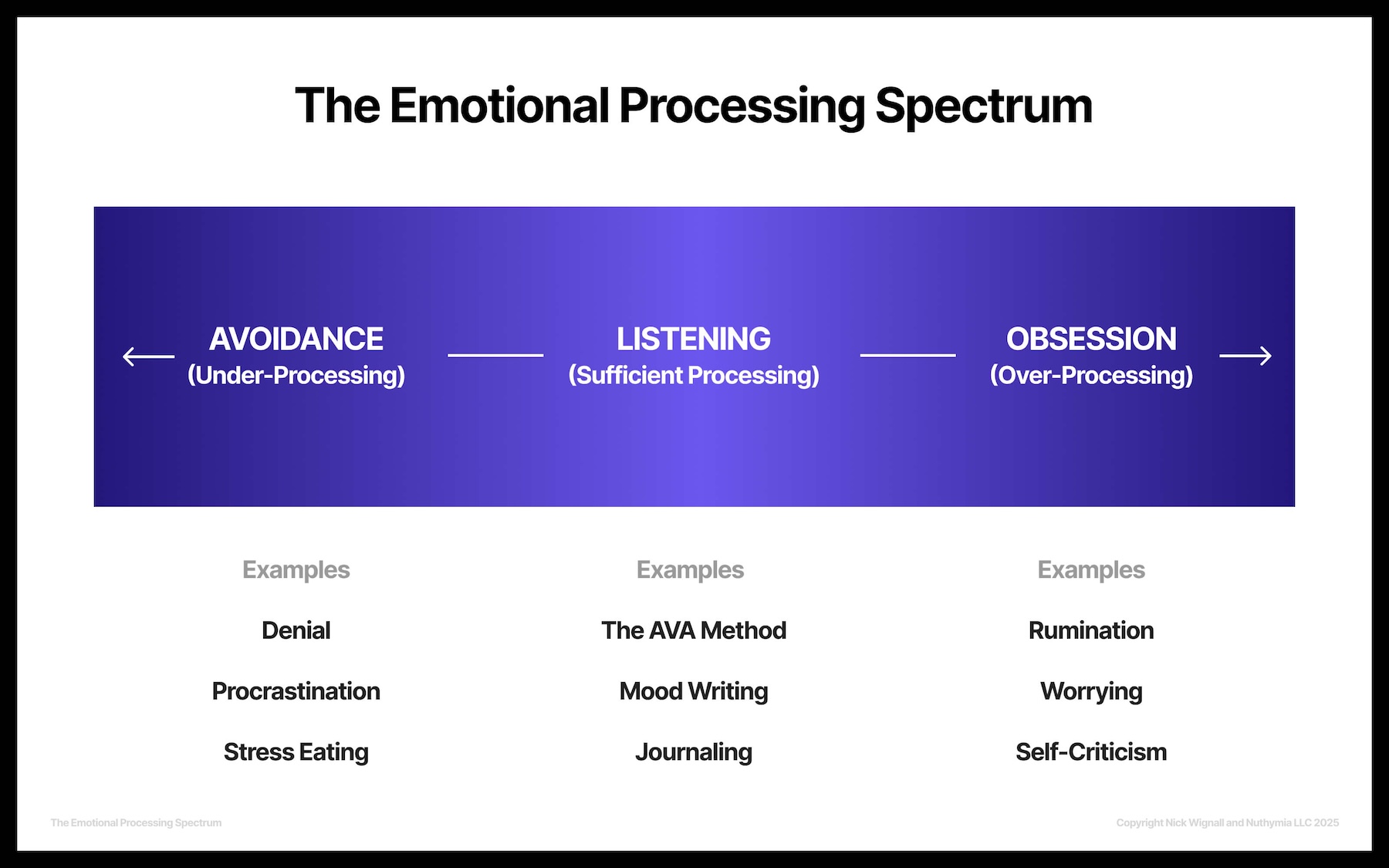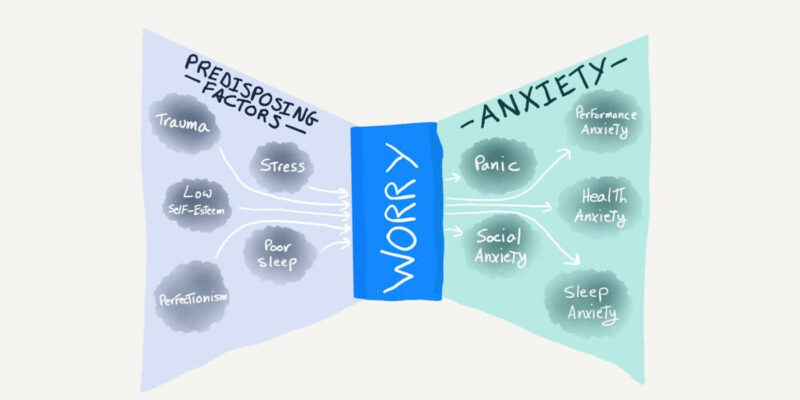If you struggle with difficult emotions like anxiety, grief, or anger, you’ve probably heard that it’s important to process your emotions instead of avoiding them.
But what does that mean exactly—process your emotions?
Today, I’m going to give you a straightforward way to think about what emotional processing is and a simple—but extremely powerful—3 step method for processing any emotion in a healthy and effective way.
What Is Emotional Processing?
If you asked most therapists to explain emotional processing, you’re probably in for an hour-long ramble about Freudian repression, inner child work, and hidden trauma.
But it’s actually much simpler than all that. Here’s how I think about it:
Emotional processing means listening to your emotions.
Imagine a spectrum (see image below):
- On the far left edge of the spectrum is AVOIDANCE. Avoidance is when your approach to difficult emotions is to ignore them and pretend they’re not there. This is a pretty unhealthy way of dealing with your emotions because by deliberately ignoring them you’re teaching your brain to think of emotions as threats and dangerous (which makes sense because your brain basically sees you running away from them all the time). Do this enough and eventually your brain starts to generate serious anxiety about emotions, which leads to low confidence, insecurity, and emotional fragility. What’s more, your emotional intelligence and self-awareness become stunted and underdeveloped (how can you understand your emotions if you always ignore them?)
- On the far right edge of the spectrum is OBSESSION. When your approach to difficult emotions is to impulsively try and fix or solve them by criticizing them, overanalyzing them, and generally getting lost in them, you’re actually teaching your brain the same lesson as in avoidance—because your brain interprets you trying to get rid of your emotions as fighting, it similarly learns to see them as threats and dangerous, which again, makes you more anxious and emotionally fragile long-term. In other words, whether your reaction to emotions is flight or fight, you get the same unhealthy outcome because you’re teaching your brain that emotions are dangerous.
- Healthy emotional processing lives in the middle of these two extremes. It involves LISTENING to your emotions and being aware of them without reacting to them or trying to control them. When you allow your emotions to just be, your brain learns that they’re safe, which leads to long-term confidence and resilience.

The good news is that the vast majority of the time healthy emotional processing doesn’t need to be a long, complicated, drawn out process:
- Just because you get a little angry when someone cuts you off on the freeway doesn’t mean you need to schedule a therapy session.
- Just because you feel sad after your spouse gives you negative feedback doesn’t mean you need to go meditate for an hour.
In fact, for 95% of the emotions you experience throughout the day—a little annoyance here, a bit of nervousness there—not doing anything is healthy processing—because you’re neither deliberately avoiding or obsessing over them.
That said, sometimes emotions are big, painful, or particularly “sticky”—and these more difficult emotions can be hard to deal with…
- Feeling a surge of defensiveness can make it hard to listen compassionately to your spouse’s feedback.
- Feeling a wave of anxiety can make it hard to share that new idea in the meeting at work.
- Getting hit with grief as you get ready for bed can make it hard to fall asleep.
In situations like these, you might need to take a more proactive approach to processing your emotions.
How to Process Difficult Emotions with The AVA Method
The AVA Method is a simple framework that will help you process any difficult emotion—from anxiety and sadness to anger and resentment—in a healthy and effective way.
AVA is an acronym standing for the three main steps:
- Acknowledge
- Validate
- Act
I’ll briefly explain each of the steps below and give you a sense for how to use it.
1. Acknowledge Your Emotions Clearly
The best way to think about acknowledging your emotions is to think about how you interact with other people.
Imagine you’re at a party and you see someone you know:
- You might say: “Oh hey, Tom, great to see! And then go over and start up a conversation.”
- Or you might just say: “Hey, nice to see you Tom,” briefly shake hands, and then go your separate ways.
But in both cases—whether you got into a discussion or moved on—you at least acknowledged the other person.
Similarly, when a difficult emotion comes up, it’s helpful to simply acknowledge the emotion and label it even if you don’t want to get into a conversation with it.
For example:
- Okay, I’m feeling pretty defensive right now.
- I’m feeling very anxious and a little sad.
- I’m not totally sure what I’m feeling, but maybe something like guilt?
It seems simplistic, but taking a few seconds to identify and label how you’re feeling is a critical first step for processing your emotions in a healthy way because it shows your brain that you’re approaching your emotions—not running away from them or trying to get rid of them.
2. Validate You Emotions Compassionately
After you’ve briefly acknowledged how you’re feeling, the next step is to take a moment to validate those feelings.
Validation sounds like one of those annoyingly vague or complex bits of therapy jargon, but it’s really very straightforward:
To validate an emotion means to remind yourself that it’s valid however uncomfortable.
For example:
- This anxiety feels awful, but it’s not surprising that I’m feeling like this given what just happened.
- I hate feeling angry, but I know that feeling angry isn’t wrong—it’s only acting on my anger that’s problematic.
- This sadness feels overwhelming, but I know it’s a normal part of the grieving process.
Validating your emotions compassionately just means briefly giving yourself the same kind of support you would give a friend who was struggling: If your friend came to you and said they were feeling really sad, you wouldn’t criticize them for feeling sad; no, you’d be supportive. Validating your emotions just means extending that same support to yourself.
3. Act on Your Values Courageously
A lot of people have the misconception that emotional processing always involves some long-drawn out process where you end up stewing on and wallowing in pain.
But even though there are times when extended emotional processing does involve sitting with an emotion for longer amounts of time, that doesn’t mean you always have to. In fact, the vast majority of the time, healthy emotional processing means very briefly acknowledging how you’re feeling, validating it, and then getting on with your life!
Step 3—act on your values—means that instead of trying to do something about your emotions (emotion-based action) you allow your emotions to be whatever they are and then do something that matters to you (values-based action).
For example:
- After your spouse gives you some tough feedback, you briefly acknowledge and validate your defensiveness, but then, instead of analyzing why you feel so defensive, you thank them for being willing to give you the tough feedback because you value honesty.
- When you’re in a meeting and feeling anxious about sharing your new idea, you briefly acknowledge and validate your anxiety, but then you allow your anxiety to be and share the idea anyway because you value creativity.
- When you feel sad lying in bed trying to sleep, you briefly acknowledge and validate the sadness, then allow it to be there while you put on a podcast to help you relax because you value health—a big part of which is getting good sleep.
Remember…
Emotional processing isn’t about fixing or coping with your emotions, it’s about listening to them and allowing them to be whatever they are as you get on with living your life according to what matters most.
Next Steps
If you enjoyed this essay, here are a few more from me that might be helpful:
Work with Me
If you’re interested in working with me directly, I have a small mindset coaching practice where I work with motivated individuals to overcome inner obstacles to success.




